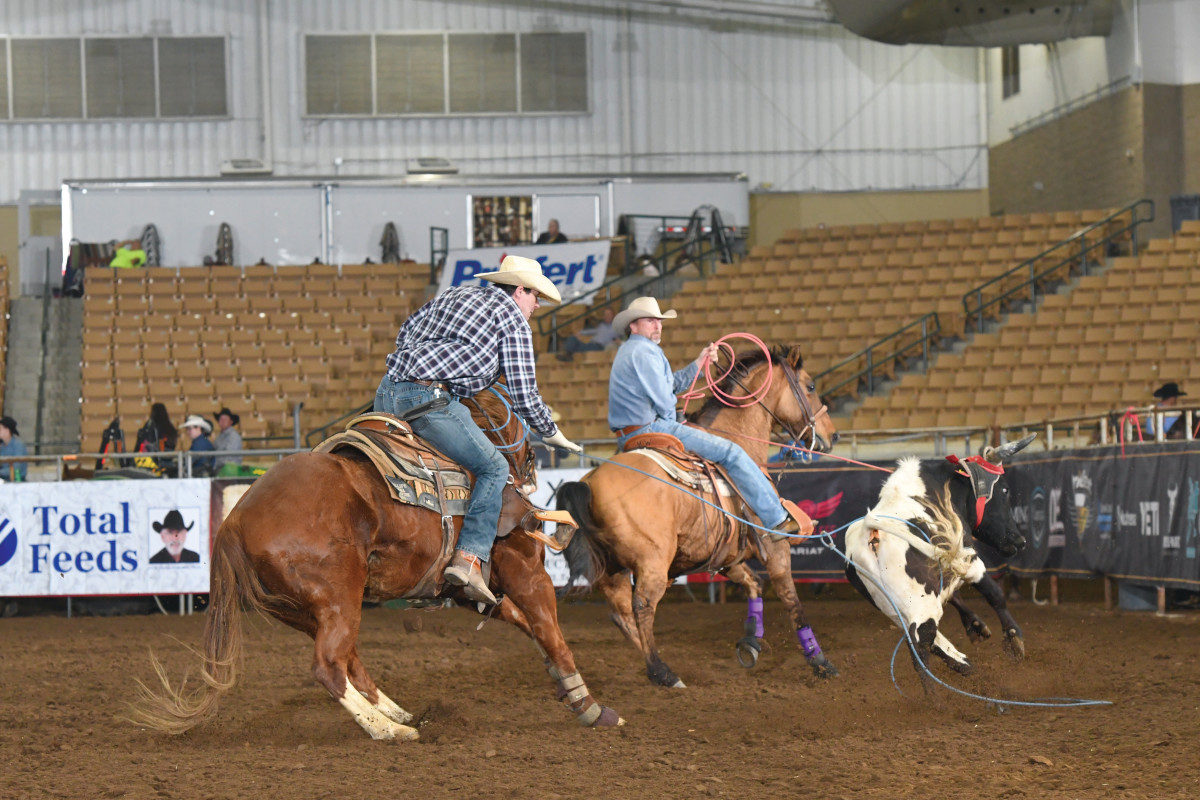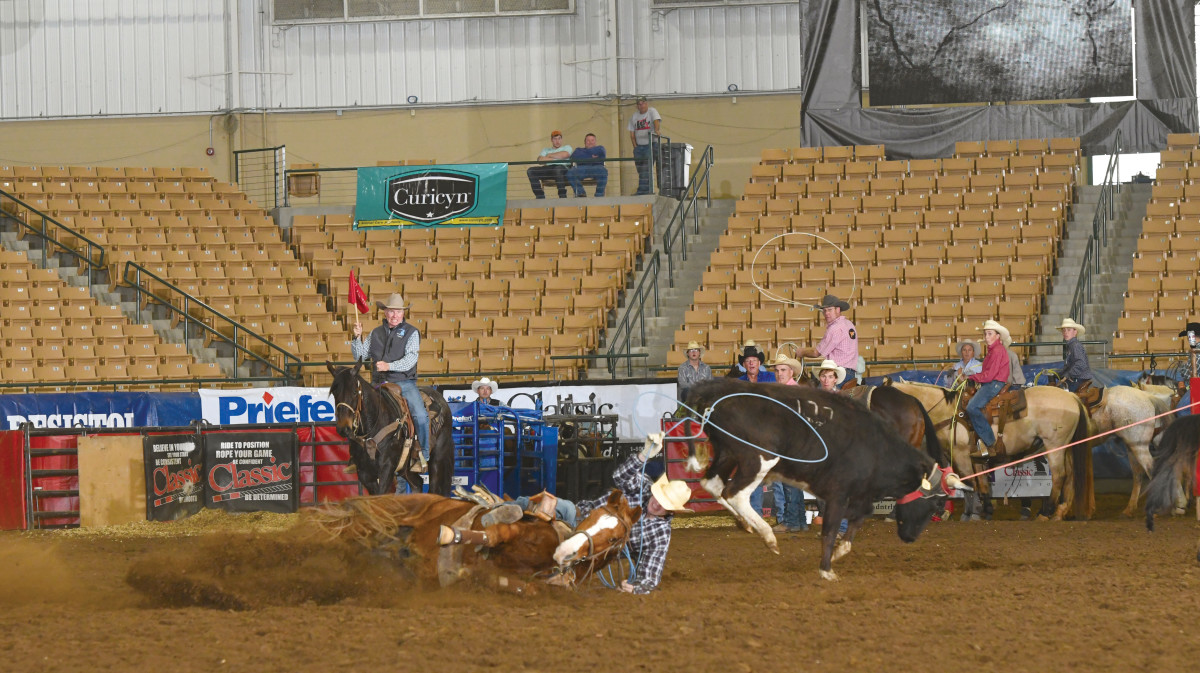Less than a year ago, in July 2018, team roping fans had a scare when they watched Chuck Jenkins’ horse go down in the arena at JX2’s USTRC Tennessee Championships in Franklin, Tennessee. Always a bad deal when a horse stumbles, the risk increases exponentially when the horse is carrying Jenkins, who lost the use of his legs in a 1998 car wreck and now straps his legs down to the saddle. Following the fall, a band of east-of-the-Mississippi ropers got together and decided Jenkins needed a new horse and mobilized. Jenkins, unaware of the effort, showed up again the next day to compete.
John Johnson, the producer behind JX2 Productions and many of the East Coast ropings has known Jenkins for a long time and has seen a horse go down with him more than once.
[LISTEN: The Score: Season 1, Episode 12 with JX2’s John Johnson]
“I’ve been doing this for about 22 years,” Johnson explained. “[Chuck] was a really good team roper before the accident, and he had a special saddle made with a board in the back from the cantle up and strapped himself in. It’s very dangerous, of course, and I have personally seen a couple horses fall with Chuck really bad over the years.”
But grit is what Johnson quickly points to when he talks about Jenkins.
“He’s such a competitor. Just resilient and tough and loves team roping. Absolutely loves team roping and just refused not to rope. Just did whatever it took, even putting himself in a lot of danger doing so.”
Jenkins, 39, though cool and casual in his demeanor, is indeed gritty. He’d grown up riding horses and, in high school, he followed the lead of some good friends and began high school rodeoing as a calf roper, steer wrestler and team roper.
“I roped every day when I was in high school. Like everybody, I wanted to make it to the National Finals,” Jenkins revealed. “But, my senior year in high school I had a car wreck. It changed everything. When I first started roping again, I was in a wheelchair.”
Jenkins had lost feeling below his waist, resulting in the loss of the use of his legs. When he told the doctors he’d ride again, they advised against it.
“I knew I was going to get back on no matter what. The doctors didn’t think it was a good idea, but I didn’t care what they thought. They didn’t think it was a very good idea at all.”
Jenkins moved ahead with his plans to ride and put in a special order with Franklin, Tennessee’s Terry Lankford of Lankford Made Custom Leather for a high-backed saddle with a strap that went around Jenkins’ waist to ensure he kept his seat. Properly geared, Jenkins went to work in the arena and saw fast results.
“It was probably seven or eight months,” Jenkins said of how long it was before he was able to get in the saddle after the accident. “But, in ’99, I went the US Finals in Oklahoma.”
In the beginning, it was a team effort to keep Jenkins roping. The wheelchair meant he needed assistance hauling, saddling and even mounting his horses.
“I could stand up and do things, but then I’d just sit back down in my chair.”
Thankfully, though, Jenkins was at first able to keep relying on his high school rodeo horse, Buddy.
“It didn’t affect him too much,” Jenkins commented on how Buddy transitioned into his new role. “I wasn’t able to really kick him, but I didn’t really have to kick him much as it was. He just kind of knew what to do on his own.”

About five years after the accident, Jenkins again took his doctors by surprise when he quit using his wheelchair.
“The doctors don’t even know how I walk, really. I can feel parts of [my legs] now, but parts of them I can’t.”
Jenkins, who imagines all the time spent in the saddle likely played a role in his ability to walk again, talks about his improved condition casually, the way one might talk about yesterday’s weather. But the significance isn’t lost on Johnson.
“It’s really a miraculous deal. He was totally in a wheelchair; totally had to be helped on his horse, strapped in, the whole nine yards. And now, the guy shows up and he can walk and it’s just unbelievable to see it. He can stand on his own. He doesn’t need assistance. He still has to strap his legs in on his saddle, but the guy ropes really good. He’s a number 6. He ropes really dang good.”
The folks who rope with Jenkins feel the same way. When his most recent mount took that spill in Franklin, they checked in with Jenkins to make sure he and his horse were all right, and it came to light that his horse was getting up in age and that, since Jenkins wasn’t in a position to get another horse at the time, the horse’s retirement would likely mean Jenkins would have to bow out of the arena, as well.
“We were standing there talking,” said Indiana roper Jeff Hartfield, who had seen Jenkins go down, “and David Gaddis, from Georgia, he said to me and Tish Luke, ‘Guys, this is crazy. This boy tries harder than anybody. All the stuff he’s overcome and all the battles he’s fought to be able to continue to be a team roper is admirable. There ain’t no way he can afford another horse that he can trust and have confidence in, given his situation. We ought to do something to help him out.’
“I said, ‘You’re right. I bet we could probably get a couple guys to pony up a little money and we could get a horse for him. So, I did the soliciting and the asking and Tish was the treasurer, collecting money from everyone.”
“We kept it quiet in the beginning,” explained Luke, a header from Florida, “because we really had to do some research. I just started looking for a horse and anything I could think of was ridiculously expensive. [Chuck] has a very good friend that he ropes with a lot, Mike Woolven. I called Mike and he said, ‘You know what, you handle the money; I’ll handle the horse.’”
As Woolven, a Mississippi roper, started narrowing the horse search, the group’s efforts were finally revealed to Jenkins.
“I didn’t really want to do it at first,” Jenkins recalled. “It’s a little hard finding a horse. Some of them, if they get real tired, I can’t kick them out of there. I can kick a little bit now, but I’ve gotta have a horse that will go by my hand, instead of having to kick-start him.”
After a few days of considering the offer, though, Jenkins, to the great joy of the group, agreed.
“This wasn’t a handout,” Luke asserted. “It was people that wanted him to continue to be able to rope. That’s not a handout.”
The idea that folks want to help out isn’t an all-new one for Jenkins.
“I think there were probably 30 or 40 people came out there when we fell,” he remembered, chuckling about the mass of ropers who jumped to immediate action when his horse went down with him strapped aboard.
Having agreed to the plan, Jenkins tried a few horses Woolven had found through another Mississippi roper and eventually chose Scout.
“We’re doing a lot better now,” Jenkins said of learning to work with his new mount. “It was a little rough at first. He’d kind of get a little antsy in the box. I’ve had two pretty good wins with him now. I’m getting used to him. And he’s getting used to me.”
In February, at the Memphis, Tennessee, USTRC Muddy River Classic, not even a year after Jenkins’ horse went down and a group of fellow ropers stepped up to remedy the situation, he was winning checks astride Scout, first when he won the average in the #12.5 Exclusive with Jason Jenkins (no relation), and then when he and Lacie Davis took second in the average in the #10.5 Exclusive. It was a great day for all involved.
“When he won Memphis, we were all more excited for him to win Memphis than if anyone of us would have won it. That was crazy. That was really exciting,” Luke enthused.
“On my end, it was just a pretty miraculous deal to see his progress,” Johnson added. “Everything is relative in life. We all have issues every day. But, I tell you, every time I see Chuck, I think, ‘My goodness.’ I mean, by God, he just refused to not rope. He wanted to freaking rope. You gotta love a guy like that.”
Hartfield agreed: “He was pretty gritty and pretty committed to ‘I’m not going to let this keep me down and I’m going to work my way back,’ which is one of the things I’ve always admired about him. That’s the reason, I think, everybody was willing to jump in and help, because Chuck’s got that don’t-quit attitude.”

In all, about 10 individuals hailing from nearly as many states committed to the effort, making contributions ranging between $200 and $2,000.
Hartfield recalls it taking only three days to get enough ropers to promise an amount to cover a horse, and Luke was able to send the last check for the horse within two months, though Jenkins was already working with Scout by the time he was paid off.
“The seller said, ‘Just keep him and make sure he’s going to work. Just mail me a check when you get it all,’” Luke reported. “He totally just sent the horse [to Chuck] and said, ‘Just mail me the money.’ And the first people that I called, they never even asked a question. They just said, ‘What’s your address,’ and mailed a check.”
While contributions did come in from as far away as Arizona, the large majority of the funds raised originated from east of the Mississippi—a fact Luke attributes to the strong sense of community shared by those roping on the eastern half of the continent.
“East of the Mississippi is very different,” Luke explained. “Maybe, because there are less of us that rope, we have to stick together more. We travel really far, so, everything is real dependent on people, and you get to know people probably better because you’re gone a little bit longer with them than if you are just heading 40 miles down the road to go to Lone Star.”
USTRC President Karl Stressman, however, wasn’t terribly surprised to hear about the endeavor.
“The rodeo, team roping and cowboy world is tremendous in that it has always been particularly understanding when it comes to tragedy and helping. Obviously, this wasn’t a tragedy, but it could have been. This world has always been about helping each other. So, it didn’t come as a surprise to me not even a little bit to say, ‘Hey, let’s raise some funds and buy a horse so we have something safe and he can continue to rope and enjoy the team roping world.’ That’s exactly what this industry is all about, and that’s the kind of people I want to associate myself with for the rest of my life, I can tell you that.”
Or, as Johnson delighted, “Just some beautiful people. As you well know, there are a lot of beautiful people in this deal.”








